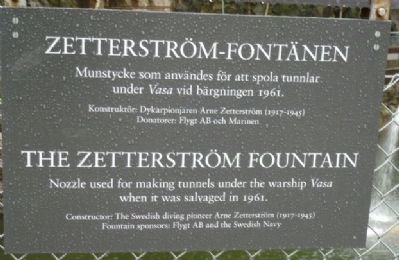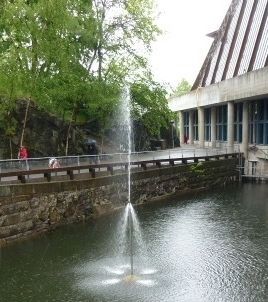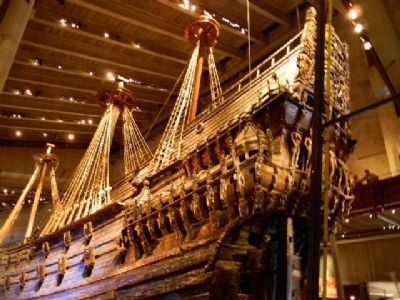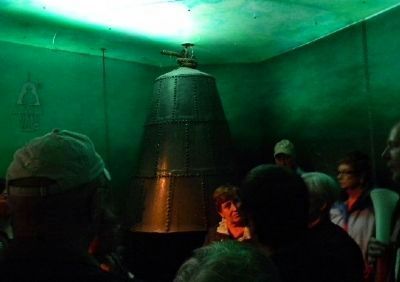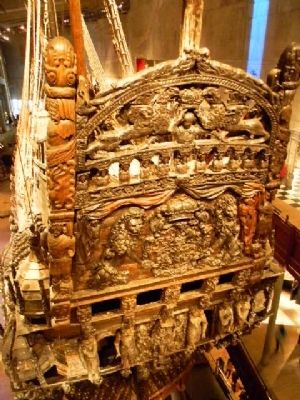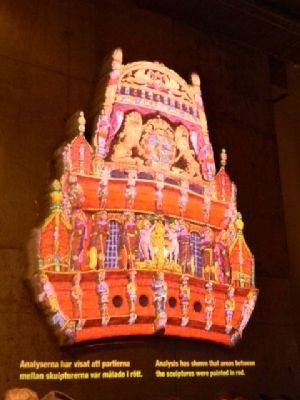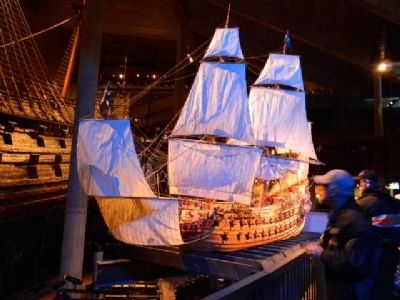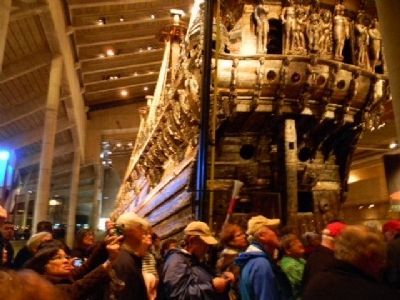Östermalm in Stockholm, Stockholm County, Sweden — Northern Europe (Scandinavia)
The Zetterström Fountain
Vasa Museum
Text in Swedish:
Mustycke som användes för att spola tunnlar
under Vasa vid bargningen 1961.
Konstructör: Dykarpionjären Arne Zetterstöm (1917-1945)
Donatorer: Flygt AB och Marinen
Nozzle used for making tunnels under the warship Vasa
when it was salvaged in 1961.
Constructor: The Swedish diving pioneer Arne Zetterström (1917-1945)
Fountain sponsors: Flygr AB and the Swedish Navy
Erected 1990 by Vasa Museum.
Topics. This historical marker is listed in these topic lists: Disasters • Man-Made Features • Wars, Non-US • Waterways & Vessels. A significant historical year for this entry is 1961.
Location. 59° 19.708′ N, 18° 5.507′ E. Marker is in Stockholm, Stockholms län (Stockholm County). It is in Östermalm. Marker can be reached from Galärvarvsvägen just west of Djurgårdsvågen. - on the fence surrounding the fountain outside the main entrance to the Vasa Museum on Djurgården Island. Touch for map. Marker is at or near this postal address: Galärvarvsvägen 14, Stockholm, Stockholms län 115 21, Sweden. Touch for directions.
Other nearby markers. At least 8 other markers are within walking distance of this marker. Galärvarvet År 1942 / Galley Yard 1942 (within shouting distance of this marker); Dytankhuset / The escape training tank house (about 180 meters away, measured in a direct line); Lyftkranen / Cranes and seaplanes (approx. 0.3 kilometers away); Villa Lusthusporten (approx. 0.3 kilometers away); Tessinska Palatset / Tessin Palace (approx. 1.1 kilometers away); Carl von Linné (Linnaeus) (approx. 1.1 kilometers away); Kung Karl XII / King Karl XII (approx. 1.1 kilometers away); Lydert Bartels' Hus (House) (approx. 1.1 kilometers away). Touch for a list and map of all markers in Stockholm.
Also see . . .
1. The House of Vasa. (Submitted on June 27, 2012, by Richard E. Miller of Oxon Hill, Maryland.)
2. Arne Zetterström (1917 – 7 August 1945). (Submitted on June 27, 2012, by Richard E. Miller of Oxon Hill, Maryland.)
3. Anders Franzen (1918-1993). ...discovered the wreck of the 1628 Swedish galleon Vasa, at Stockholm Harbor in 1956... From 1959 to 1961, he conducted her salvage [employing the Zetterström Nozzle in raising her hull from the depths] "the most complete ship of the era." (Submitted on June 27, 2012, by Richard E. Miller of Oxon Hill, Maryland.)
4. The Swedish Ship Vasa's Revival. (Submitted on June 28, 2012, by Richard E. Miller of Oxon Hill, Maryland.)
Additional keywords. Wasa; Thirty Years War; Vasamuseet; Royal Djurgården Park; King Gustav II Adolf [Gustavus Adolphus]
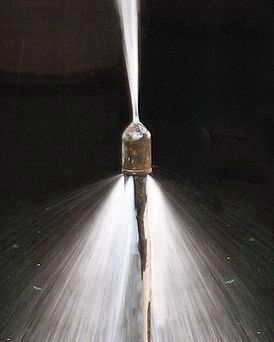
Photographed By Wikipedia
3. Close-up of the "Zetterström Nozzle"
Vasa lay at a depth of 32 meters. The navy’s heavy divers were able to cut six tunnels through the clay under the ship with special water jets [i.e. the Zetterström Nozzles]. Steel cables were drawn through the tunnels and taken to two lifting pontoons on the surface, which would pull the ship free of the harbour bottom’s grip. In August 1959, it was time for the first lift. . . .
Credits. This page was last revised on August 27, 2022. It was originally submitted on June 27, 2012, by Richard E. Miller of Oxon Hill, Maryland. This page has been viewed 4,766 times since then and 50 times this year. Photos: 1, 2, 3, 4, 5, 6, 7, 8, 9. submitted on June 27, 2012, by Richard E. Miller of Oxon Hill, Maryland. • Bill Pfingsten was the editor who published this page.
